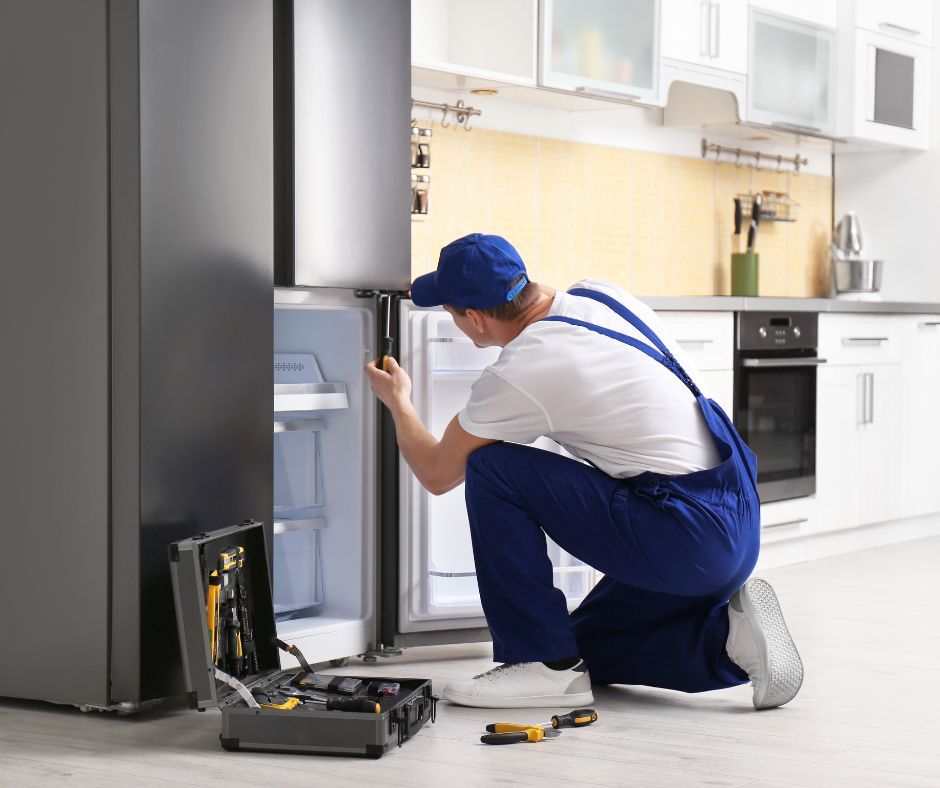One of the most challenging appliances to move is the refrigerator. But with proper planning and preparation, you can safely and
securely transport your fridge to its new home. This comprehensive guide will walk you through the steps to pack and move your refrigerator without a hitch.
Pre-Move Safely Pack and Move a Refrigerator
Assessing Your Refrigerator
Before you start, understand the type and model of your refrigerator. Is it a double-door or a standard model? Knowing this will help in planning the move.
Planning for the Food
- Empty the refrigerator of perishable items.
- Use up as much as you can before the move.
- For items you can't consume, consider donating to a local food bank or giving them to neighbors.
Necessary Supplies
Prepare a list of supplies you'll need:
- Moving straps
- Furniture blankets
- Packing tape
- Bubble wrap or shrink wrap
- Dolly or moving rollers
- Bungee cord
Preparing the Refrigerator for Moving
Emptying the Refrigerator: Remove all food items, ensuring the fridge and freezer compartments are empty. This reduces the weight and prevents any damage during the move.
Cleaning and Defrosting: Unplug the refrigerator and let it defrost. This might take several hours. Once defrosted, clean the interior with a disinfectant. If your fridge has an ice maker, disconnect it from the waterline.
Handling the Ice Maker: Ensure the ice maker is empty and frost-free. Remove it and pack it separately.
Securing Internal Components
Removing Loose Parts: Take out shelves, racks, and containers. Wrap them in bubble wrap or styrofoam to prevent damage.
Protecting Internal Parts: Secure loose internal parts using packing straps or tape. This ensures they don't move during transport.
Dealing with Doors: If your refrigerator has double doors, secure them using moving straps or a bungee cord to ensure they remain closed during the move.
External Preparations for Moving Refrigerator
Power Cord and Plug: Pair the power cord against the back of the fridge using packing tape. This prevents them from dangling and getting damaged.
Protective Packaging: Wrap the refrigerator in moving blankets or bubble wrap. Secure with packing tape. This protects the exterior from scratches and dents.
Securing Doors: Use moving straps or bungee cords to keep the doors closed during transport.
Moving the Refrigerator
Using a Dolly: Refrigerators are heavy objects. Using a dolly or moving rollers makes the task easier. Ensure the refrigerator remains upright during the move to protect the cooling mechanism.
Transporting Upright: Always transport the refrigerator in an upright position. This ensures the compressor and coolant function properly after the move.
Loading into a Truck: With the help of helpers, load the refrigerator into the moving truck. Use moving straps to secure it, ensuring it doesn't move during transport.
Post-Move Tips
Packing and moving a refrigerator requires careful planning and attention to detail to ensure the appliance's safety and a smooth transition to your new location. Here are some post-move tips to consider once you've successfully moved your refrigerator:
- Let the Refrigerator Stand Upright: Once you've moved the refrigerator to your new location, allow it to stand upright for at least 3-4 hours before plugging it in. This time allows the refrigerant and oil to settle back into their proper places, preventing potential damage to the compressor.
- Clean and Disinfect: Before using your refrigerator, clean and disinfect the interior and exterior. Use mild soap and water to clean the shelves, drawers, and surfaces. Make sure to rinse thoroughly to remove any soap residue. You can also use a food-safe disinfectant.
- Check for Damage: Inspect the refrigerator for any signs of damage or shifting during the move. Look for dents, scratches, or any other issues that might have occurred during transportation.
- Level the Refrigerator:
Ensure that your refrigerator is level. An uneven refrigerator can cause it to malfunction and lead to cooling issues. Use a levelling tool to check the balance and adjust the feet.
- Plug It In: Once the refrigerator has settled and you've cleaned and inspected it, plug it into the electrical outlet. Allow it to run for a few hours to ensure it's cooling correctly. Check the temperature settings and adjust as necessary.
- Gradually Fill the Refrigerator:
Instead of loading the refrigerator with a large quantity of food immediately, slowly add items over a day or so. This helps the appliance cool down evenly and efficiently.
- Monitor Temperatures: Monitor the temperature settings in refrigerator and freezer compartments. The ideal refrigerator temperature is around 37°F (3°C), and the freezer should be set to 0°F (-18°C).
- Stock the refrigerator Wisely: Consider proper organization when placing items in the fridge. Keep perishable foods at safe temperatures and avoid overloading the shelves, which can impede air circulation and cooling efficiency.
- Stay Patient:
After plugging in your refrigerator, reaching the desired temperature and cooling effectively might take up to 24 hours.
- Check for Leaks: After a few hours of operation, check for any water leaks around or under the refrigerator. Leaks could indicate a problem with the water line, condensation, or a blocked drainage system.
- Maintain Proper Ventilation: Clear space around the refrigerator's coils and vents. Proper ventilation is crucial for efficient cooling and preventing the appliance from overheating.
- Refer to the Manual:
If you encounter any issues or have questions about your specific refrigerator model, consult the manufacturer's manual or customer service for guidance.
By following these post-move tips, you can help ensure that your refrigerator is appropriately set up, functioning efficiently, and ready to store your food items in your new home safely.
Additional Tips and Tricks
DIY vs. Professional Movers
While moving the refrigerator yourself can save costs, hiring
professional movers ensures safety and reduces the risk of damage.
DIY and professional movers have advantages and disadvantages when safely packing and moving a refrigerator. Let's explore both options:
DIY (Do-It-Yourself)
Advantages:
- Cost-Effective: DIY moving can be more budget-friendly since you won't have to pay for professional services.
- Control: You have complete control over the packing and moving process, which can be reassuring for some individuals.
- Flexibility: You can schedule the move according to your timeline and preferences.
Disadvantages:
- Physical Demands: Moving a refrigerator is physically demanding and potentially risky, especially if you need the proper equipment or experience.
- Safety Concerns: Lifting heavy appliances can lead to back strains, injuries, and damage to the refrigerator itself.
- Lack of Expertise: With proper knowledge, you might know the best techniques to ensure the refrigerator is adequately secured and protected during transit.
Hiring Professional Movers
Advantages:
- Expertise: Professional movers are trained and experienced in handling heavy and fragile items, including refrigerators.
- Safety: They have the necessary equipment (dolly, straps, padding) to safely move the refrigerator without causing damage to it or your property.
- Efficiency: Professionals can pack and move the refrigerator more quickly and efficiently, saving time and effort.
- Insurance: Reputable moving companies often provide insurance coverage for any damage that might occur during the move.
Disadvantages:
- Cost: Hiring professional movers can be more expensive than doing it yourself, particularly if you're moving on a tight budget.
- Less Control: You need more control over the exact timing of the move and the handling of your belongings.
- Scheduling: You'll need to coordinate with the moving company's schedule, which might only sometimes align with your preferences.
Common Mistakes to Avoid: Avoid laying the refrigerator down, not letting it rest after the move, and not checking the cooling tubes and evaporator before plugging it in.
Maintenance After Moving: Once set up, ensure regular refrigerator maintenance to keep it in top shape.
FAQs:
- Can you lay a refrigerator down to move it? No, always keep it upright to protect the cooling tubes and refrigerant oil.
- How long should a fridge rest after moving? Ideally, 3-4 hours to allow the coolant to settle.
- What to do if the refrigerator doesn't start immediately after the move? Check the power cord and plug, and ensure the compressor functions correctly.
Moving a refrigerator requires careful planning and execution. Following this guide ensures your appliance reaches its new home safely and securely. Preparation is key; you can make this task hassle-free with the right tools and techniques.
I hope this comprehensive guide helps you in your moving endeavors. Feel free to reach out if you have any questions or need further assistance. Safe moving!


